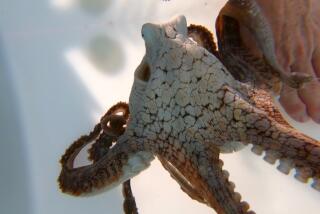Peafowl Pact: Trap Some, Leave the Rest
PALOS VERDES ESTATES — In a move both hailed as a compromise and denounced as the prelude to a “peacock holocaust,” the City Council this week voted to allow residents offended by the city’s roaming peafowl to trap and remove them from their property on a controlled basis.
Trapping was outlawed more than a year ago after 51 birds were removed from the city, leaving 67, according to the most recent census last fall. The city has been searching for a solution to the longstanding peafowl dispute, which has pitted residents who value the birds as a unique community asset against those who find them noisy, messy and damaging nuisances.
Under the program recommended by City Manager Gordon Siebert and passed Tuesday by a 4-1 vote, trapped birds will be taken out of the city until a specific number has been taken from each of the city’s two flocks: 10 from behind the Malaga Cove Library and 15 from the Espinosa Circle area.
Additional birds may be trapped, but they will be relocated in city park lands. Birds may not be removed from the city again until census counts, to be done three times a year, show that flocks have grown.
‘Middle of 2 Extremes’
Mayor James H. Kinney called the plan “a position in the middle of two extremes, one to classify the birds as wildlife and allow them to be totally protected, and the other to eliminate them all.”
But a group of peafowl partisans said they will seek a court injunction against the trapping plan on the ground that the city is changing the environment without conducting an environmental impact study as required by law.
“Not one bird should be trapped until we get expert advice,” said Carl G. Allen, a member of the city’s peafowl study committee, which the council appointed last summer to study the issue. Allen said the group, called Friends of the Peacocks and made up of former committee members, also will try to place a measure on the ballot to protect the peafowl.
Allen and other peafowl supporters contend that the birds’ critics are a small, vocal minority, but Tuesday’s 2 1/2-hour public hearing, which drew about 100 people, appeared to be dominated by peafowl critics.
‘Number Not Relevant’
Attorneys Marshall Silberberg and Lee Horton, who spoke for a large group of Espinosa Circle residents, argued that there should be no limit on the number of birds that may be removed if they are a nuisance.
“The number is not relevant,” said Silberberg, who said peafowl once broke into his bedroom and did $1,700 damage. “Residents should have the right to eliminate this problem if the use of their property is interfered with.”
Horton warned that the city could be opening itself to legal problems if it refused to “let people eliminate a nuisance.”
But after the council vote, Horton said the decision “reflected the interest of both sides.”
Study committee member Gar Goodson accused the council of ignoring the committee’s report, which recommended that the birds be protected as wildlife and that no trapping be done at this time. A minority report submitted by one study committee member said flocks should be thinned.
Property Rights Cited
Kinney said the council has listened to all sides on the peacock issue, including the committee, which “it did not agree with.” He said the issue is the “fundamental right of people to the free use of their property,” adding that the peafowl problem has increased in recent years because flocks have increased and there has been more development.
Councilwoman Barbara J. Culver said the plan “guarantees that the flocks will not be decimated” because it sets limits on how much they may be reduced.
The trapping plan prohibits separating mother hens from their chicks, and any trapped chicks would be released. Trapping will be done by the Southern California Humane Society at the request of owners, who will pay the city a $10 fee for each use of a trap. Birds removed from the city will be taken to the society’s wildlife preserve in Little Tujunga Canyon in the San Fernando Valley. Trapping could begin in four to six weeks after the city purchases six traps for a total of $900.
Despite the predominance of critics at the hearing, which was generally subdued despite the emotional nature of the issue, the peafowl did have friends among residents.
Attorney Michael Williams said the peacocks were one of the things that persuaded his family to move to the city in June. “They’re nice,” he said.
Longtime resident Ward Proudfood said he loves the wildlife that visits his property, including foxes, owls, skunks and peacocks: “We’re after peacocks now, but what will be next? We’re getting too citified.”
More to Read
Sign up for Essential California
The most important California stories and recommendations in your inbox every morning.
You may occasionally receive promotional content from the Los Angeles Times.










